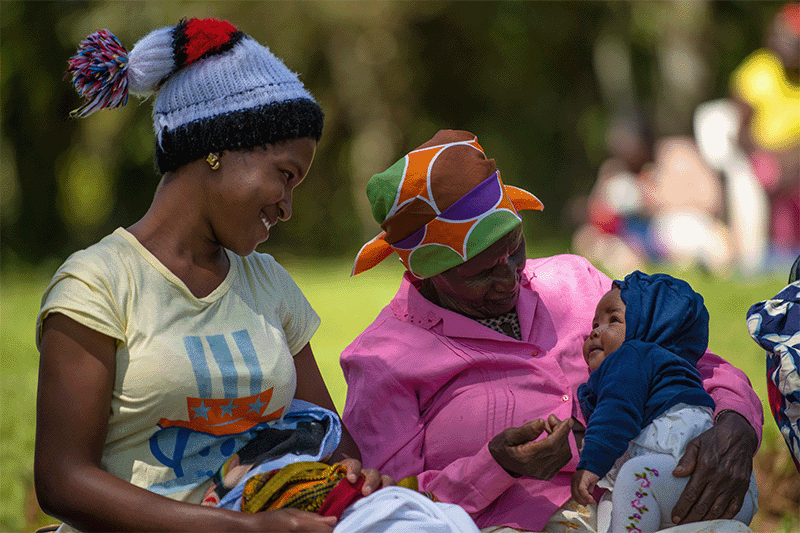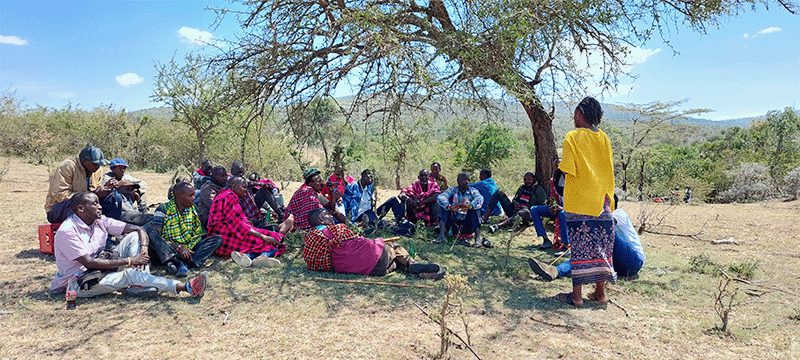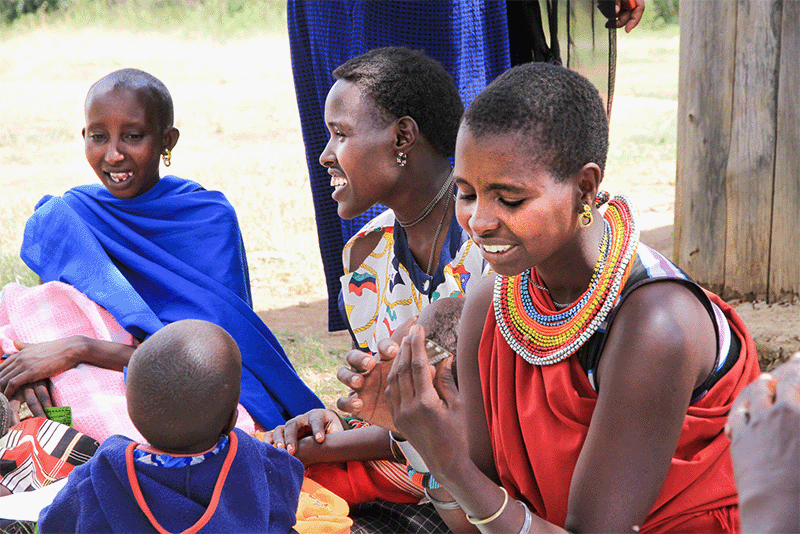Spotlight on CHASE Africa: Strengthening Integrated Health and Environment Programs through Strategic Partnerships in East Africa

CHASE Africa is a UK-based non-governmental organization that empowers rural communities in Kenya and Uganda through mobile health and family planning outreach clinics, alongside sexual and reproductive health and rights education, and support with natural resource management. We spoke with CHASE Africa’s CEO, Harriet Gordon-Brown, to learn about the organization’s strategic partnership work, and their support in developing integrated health and environment programs. This article was initially published on People-Planet Connection.
Please briefly introduce yourself and CHASE Africa’s work.
My name is Harriet Gordon-Brown, and I joined CHASE Africa in August 2020 as a program and partnership manager. When our director retired last summer, I took over as CEO. CHASE Africa, which stands for Community Health and Sustainable Environment, has been supporting rural communities in Kenya and Uganda for the past 10 years. We grew out of a previous charity that had an environmental focus. When forming CHASE Africa, our founder and director, Robin Witt, took a big shift to emphasize women’s reproductive health and address the unmet need for family planning.
Our vision is healthy, empowered communities living sustainably with their natural environments. Our mission is to support partner organizations, in Africa, that enable access to healthcare, family planning and rights, while protecting the environment and building resilience to climate change.
We believe in the interconnections between human and environmental health. We work particularly with communities where their lives and livelihoods are very dependent on natural resources and their local environment. Either through small scale integration or through our partners and where we work, we try to support parallel environmental activities, all with the aim of improving people’s lives and livelihoods.
CHASE Africa local partner organizations:
- Community Health Africa Trust
- Big Life Foundation
- Dandelion Africa
- Kalyet Afya Foundation
- Mount Kenya Trust
- Community Health Volunteers
- The Maa Trust
- Rwenzori Centre for Advocacy and Research
- RICE-West Nile
- Save the Elephants
- Southern Rift Association of Landowners (SORALO)
- Milgis Trust
- Wildlife Works
What steered CHASE towards a cross-sectoral approach to health, environment, and development?
It really came from Robin Witt, who founded CHASE and is still actively involved with our fundraising and contributing to the strategy.
He had formed an organization called the Rift Valley Tree Trust, which focused on forest restoration. His wife is Kenyan and throughout the many years he spent visiting the country, he noticed a lot of deforestation. This inspired his development of reforestation projects. However, after visiting some of the projects and having more and more conversations with women in the affected areas, he realized that actually these reforestation projects were only addressing one of their needs. Their access to health services, including family planning and their ability to realize their sexual reproductive health and rights, was very limited. And he realized this is actually the bigger problem that needed addressing. That led to a significant shift in 2012, and the formation of CHASE Africa. Now the majority of our funding goes towards the health component of the work. It is in large part due to the organizations that we have chosen to partner with that we have taken a more integrated approach.

Can you talk a little more about the importance of partnership in your work, and describe what your process of working with partners looks like?
Our partnerships are very crucial to how we work. We work entirely through local partners. We don’t implement projects ourselves, and at the moment, we don’t have any staff on the ground. If we do expand to have an in-country presence, we would still implement through local partners as we feel they are best placed. We intentionally choose local partners who already have strong community links through the work they’re doing or because they’ve grown out of the local community themselves. This is the model of delivery that we’ve chosen to support. It’s what CHASE has always done and will always continue to do.
Year by year we have increased the number of partners we work with. Currently we have 13 partners. More recently, our approach has been to partner with projects that don’t have a health program, and support them to layer in a health component to their existing work. We also have a couple of partners who were working in health, but not reproductive health. And again, it’s about layering in additional, complementary services.
An example of how we try to strengthen the existing health infrastructure and avoid duplication of effort is the fact that all of our partners work with the Ministry of Health. They are a key partner to our programs. It’s our partners that form and develop memorandums of understanding with the local Ministry of Health.
What are some of the largest challenges you are facing within your work in integrated health and environment programs? And what has your organization done to address these challenges?
There is a huge need for information provision around health—there are a lot of myths and misconceptions. We are working largely in societies that are quite patriarchal and in fairly remote areas where the level of education varies substantially, and there is especially very little (or no) sex education in schools. The first step is to provide people with information, so they understand how their bodies work, and how they can improve their reproductive and sexual health and rights. For many women, once they realize they can choose when and how often to space their pregnancies, family planning doesn’t require a lot of persuasion. They know that it will make life easier for them, appreciate that it’s better for their health and enable them to care and educate the children they have. The second step is doing a lot of work to educate and engage men since they are often the decision-makers. This involves, for instance, hosting men’s dialogues and identifying male role models. These approaches are very effective, but it’s still an ongoing challenge.
More recently, we have been focussing more on the challenge of reaching adolescents and youth since many of the communities we work with experience high rates of teenage pregnancy and early marriage. Similar to the challenge with reaching women, youth often don’t have agency to make decisions about their own lives. That’s why working in parallel with our wider community programs is very effective. Thanks to new approaches we’ve learned from our partners, we are now doing more work around raising awareness about sexual and reproductive health and rights in parallel with making service provision more adolescent and youth friendly.
The work is done both in and out of school. With the in-school work, many of our partners are implementing what they call “child rights clubs,” which are effective. This involves educating girls about menstrual health and helping to reduce the amount of girls who can’t attend school due to a lack of access to menstrual health products. The clubs also ensure girls are aware of their rights more broadly—teaching them what to do if they feel their rights have been violated, and how they can report it. The clubs also provide girls and boys with information about their health, including sexual and reproductive health, since the schools often lack comprehensive sex education and it is often taboo to talk about sex within families. It’s about providing people with information, which can lead to wider discussions around their future plans, career opportunities or other training they may need.
As for reaching adolescents and youth out of school, we take a proactive, “youth-engaging-youth” approach where our partners train up youth peer mentors and youth champions so they are the ones delivering messages to their peers. They organize different events, including sporting events, and try to reach youth in innovative ways, depending on places they frequent in the community. It could be around the pool hall, in a village, where people collect water from, or at the Boda Boda motorbike stations.

Do you have any innovations in integrated health and environment work that your organization is developing or implementing?
One of our strengths is our work with conservation organizations—supporting them to integrate a health component into their programs. Through this partnership and building on their existing infrastructure, we are able to use the skills and expertise that they have developed for community engagement on complex issues such as human-wildlife conflict, management of communal natural resources and land rights to providing information and having open and difficult discussions around sexual and reproductive health and rights with communities. We are keen to share this experience with other organizations and have written a guide “Supporting Community and Ecosystem Health. A guide on why, and how, to include community health and rights based family planning in conservation programmes”, and have shared our experience with other locally based conservation organizations. We are also a member of the IUCN Taskforce on Biodiversity and Family Planning.
While we provide funding for these initiatives, the conservation partners coordinate outreach services from the existing health facilities in the region. This includes things like mobile outreaches and what we call “backpack nurse” services where a nurse travels to remote areas on the back of a motorbike to deliver health services from an existing Ministry of Health clinic.
We currently have seven local conservation partners who are doing this type of work, and we’re interested in expanding to engage others.
Going forward, we also want to demonstrate how health can be layered with other programmes by organizations that are working with rural communities (including WASH, education, agriculture or micro-finance). We will be exploring possible partnerships to this effect.

What are some of CHASE Africa’s accomplishments achieved across the years that you are most proud of?
I’m proud of the health information that we’ve delivered, and the uptake of services. While we’ve grown as an organization, we are still quite small with fairly simple monitoring and evaluation systems for measuring behavioral change communication. However, we have significant anecdotal evidence on the change in attitudes, alongside increased service uptake in areas where we’ve worked, to demonstrate that our method of engaging communities and facilitating dialogues is really effective.
I’m also proud that we’ve been doing the work in a more sustained way. We don’t just deliver services in one place and move on. We partner with people who have long-term commitment to these communities. We know this type of change takes time. It doesn’t happen overnight.
The staff in our partner organizations who are running the projects are often the only health experts in their organization. Therefore, it’s helpful for them to be able to learn from other people running similar programs in other places and facing similar challenges. We have been able to facilitate a great amount of cross-learning between projects. For instance, we support exchange visits and we provide and facilitate regular opportunities (webinars and an annual conference) where our partners can learn from one another.
What are some important lessons you’ve learned through your experiences in cross-sectoral work?
I come from a background in integrated rural development, so I’ve always known that people’s problems and challenges are interconnected. And yet, a lot of development work is done in a very siloed manner. I think there is a huge scope to tackle people’s problems in a holistic way, whether it’s poverty, poor health, or poor access to services. It’s multifaceted and therefore requires an integrated approach. And I think that working with partners who have long-term commitments to communities and are building the capacity of those communities at the same time is a really valuable way to make change and to empower those communities to be making change themselves.
Is there anything else you’d like to share about your work?
Our integrated work takes place in different ways. As I’ve mentioned, we have programs with conservation partners, but we also have partners doing work in rural areas that are not connected to conservation spaces or organizations. They are integrating health and environment work at the community level to address issues for people whose lives and livelihoods are very reliant on natural resources.
These partners, one of whom is The Rwenzori Center for Research and Advocacy, are doing health work in tandem with tackling issues such as food insecurity and climate change, building climate change resilience, and improving community structures to strengthen natural resource management. This can include, for example, supporting the use of cookstoves to reduce the environmental burden of forest degradation, which also benefits women by reducing the time needed to collect firewood and prepare food. It also includes kitchen gardens and climate smart agriculture to improve nutrition, build resilience to climate change and provide opportunities for income generation.




